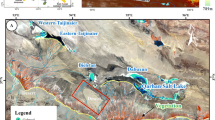Abstract
Reticulate dunes are one of the commonest dune types, and yet the least understood. Reticulate dunes at southeastern Tengger Desert are constituted by NE-SW trending primary ridges and nearly vertical secondary ridges. The result of field work studying the morphodynamics and formation mechanism for reticulate dunes in this area shows that the primary ridges were formed by dominant northwest wind and the secondary ridges developed and maintained by alternating dominant wind and subdominant northeast wind on the basis of the primary ridges. Viewed from morphodynamics, reticulate dunes correspond to the complex transverse dune on which the longitudinal element superimposed.
Similar content being viewed by others
References
Cook, R., Warren, A., Goudie, A.,Desert Geomorphology, London: UCL Press, 1994, 526.
Zhu Zhenda, Wu Zheng, Di Xingwin et al.,Introduction of Deserts in China (in Chinese), Beijing: Science Prees, 1981, 107.
Wu Zheng,Aeolian Sand Geomurphology (in Chinese), Beijing: Science Press, 1987, 87–153.
Cooper, W. G., Coastal sand dunes of Oregon and Washington,Geol. Soc. Am. Mem., 1958: 72: 169.
Wilson, I. C., Aeolian bedforms—Their development and origin,Sedimentology, 1972, 19: 173.
Hunter, R. E., Basic types of stratification in small aeolian sand dunes,Sedimentology, 1977, 24: 361.
Bagnold, R. A.,The Physics of Blown Sand and Desert Dunes, 2nd ed., London: Chapman and Hall, 1954, 265.
Ha Si, Dune morphometry and its affecting factors at the southeast fringe of Tengger Desert,Journal of Desert Research (in Chinese), 1995, 15: 136.
Fryberger, S. G., Dune form and wind regime, A study of global sand seas, in.US Geol. Suru. Prof. Paper 1052 ((ed. Mckee, E. D.), Washmgton: US Government Printing Office, 1979, 137–170.
Tsoar, H., Dynamic processes acting Pye a longitudinal (seif) dunes,Sedimentlogy, 1983, 30: 567.
Pye, K., Tsoar, H.,Aeolian Sand and Sand Dunes, London: Unwin Hyrnan, 1990, 1–392.
Ha Si, Grain-size characteristics and mechnism of reticulate dunes at the southeast fringe of Tengger Desert,Geographical Study (in Chinese), 1998, 18: 178.
Ha Si, Wang Guiyong, Relations between gram-size features and slope shapes of transverse dunes at southeast fringe of Tengger Desert,Journal of Desert Research (in Chinese), 1996, 16: 215.
Vincent, P. J., Particle size variation over a transverse dune in the Nafud as Sirr., Central Saudi Arabia.J. Arid. Environ., 1984, 7: 329.
Lancaster, N.,The Namib Sand Saa, Rotterdam: Balkema, 1989, 1–181.
Folk, R. L., Longitudinal dunes of the northwestern edge of the Simpson Desert, northern Territory, Australia, 1, Geomorphology and grain size relationships,Simentlolgy, 1971, 16: 5.
Lancaster, N., Grain size chracteristics of linear dunes in the southwestern Kalahali,J. Sediment. Petrol., 1986, 55:395.
Tsoar, H., Internal structure and surface geometry of longitudinal (seif) dunes,J. Sediment., 1982, 52: 823.
Mckee, E. D., Tibbitts, G. C., Primary structures of a seif dune and associated deposits in Libya,J. Sediment Petrol., 1964, 34: 5.
Mckee, E. D., Sedimentary Structure in Dunes of the Namib Desert, Southwest Africa,Spec. Pap. Geol. Soc. Am. 1982, 188: 1.
Hunter, R. E., Richmond, B. M., Alpha, T. R., Storm-controlled oblique dunes of the Oregon coast,Bull. Geol. Soc. Am., 1983, 94: 1450.
Mckee, E. D., Introduction to a study of global sand seas, inUS Geol. Surv. Prof. Paper 1050((ed. Mckee, E. D.), Washington: US Government Printing Office, 1979, 1–19.
Lancaster, N.,Geomorphlolgy of Desert Sand Dunes, London: Routledge, 1995, 1–332.
Handisty, J., Whitehouse, R. J. S., Evidence for a new sand transport process form experiments on Saharan dunes,Nature, 1988, 332: 532.
Author information
Authors and Affiliations
Additional information
Project supported by the National Natural Science Foundation of China (Grant No. NSFC-49501001).
Rights and permissions
About this article
Cite this article
Ha, S., Dong, G. & Wang, G. Morphodynamic study of reticulate dunes at southeastern fringe of the Tengger Desert. Sci. China Ser. D-Earth Sci. 42, 207–215 (1999). https://doi.org/10.1007/BF02878520
Received:
Issue Date:
DOI: https://doi.org/10.1007/BF02878520



